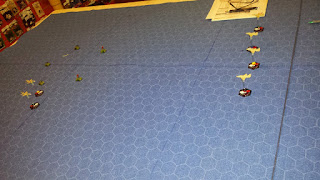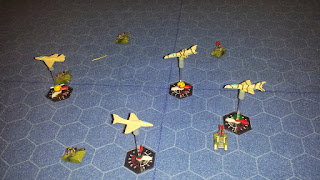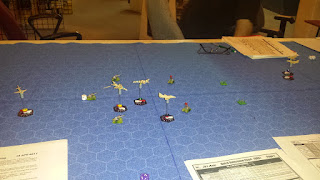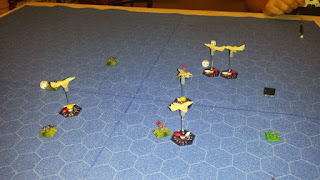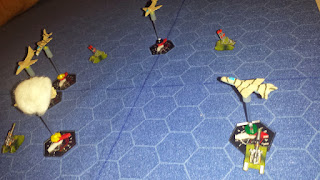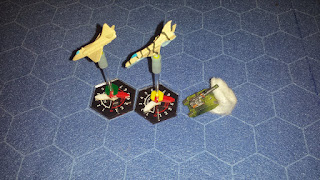Sorry for the lack of activity! It seems after years of contract work, I
finally landed a Permanent Position!
With my Professional Life stabilizing, hopefully I can post more
frequently than of late!
So Graham wanted to do some “Check Your 6! Jet Age” and this was the next mission in the
campaign book: “Star And Pyramid”. So,
away we go!
Date: 25 July, 1970, 1000hrs.
Location: West of the Suez Canal (Egypt)
CAB: Low & Surface Low (Ground level to ~
9000ft)
Situation: The Soviets had started deploying their own
troops and pilots to Egypt. Israel
restricted missions to within 25 miles of the Suez to prevent engaging the
Soviet pilots. It didn’t always work…
A flight of Israeli A4’s is on their way to attack an
artillery position when they are intercepted by Soviet Fighters in the area.
Mission:
3 Artillery Guns, with 2 Light AA Weapons and 2 Man-Portable SA-7 IR Missiles protecting the guns.
AA and SA-7 must roll a D6 and roll 3+ to target an enemy fighter within 6 hexes of a friendly. If failed, they MUST target the friendly aircraft.
3 Artillery Guns, with 2 Light AA Weapons and 2 Man-Portable SA-7 IR Missiles protecting the guns.
AA and SA-7 must roll a D6 and roll 3+ to target an enemy fighter within 6 hexes of a friendly. If failed, they MUST target the friendly aircraft.
Israeli:
4 X A4H’s must try to destroy the 3 guns. Each Gun is a Point Target and takes 2 Damage Points to destroy. The A4’s have a Medium Bomb Load and count as Fully Loaded.
4 X A4H’s must try to destroy the 3 guns. Each Gun is a Point Target and takes 2 Damage Points to destroy. The A4’s have a Medium Bomb Load and count as Fully Loaded.
Soviet:
MiG 21MFs have 4 X AA2 IR Missiles each. Shoot down the Israeli Aircraft before they complete their missions.
MiG 21MFs have 4 X AA2 IR Missiles each. Shoot down the Israeli Aircraft before they complete their missions.
Optional Rules:
Soviets: One SA-7 Battery has Skilled Crew instead of Green
Israeli: Half the A4’s (1 Skilled and 1 Green) are delayed and don’t arrive until turn 3
Soviets: One SA-7 Battery has Skilled Crew instead of Green
Israeli: Half the A4’s (1 Skilled and 1 Green) are delayed and don’t arrive until turn 3
Deployment:
Guns were deployed as far away from the Israeli Table edge
as the rules permitted. Light AA was
deployed in between Israeli and Guns.
The SA-7 missiles were deployed hidden – to be revealed when (if) they
fired their missiles.
Deployment Before the Optional Rules were rolled...
Israeli Deployment AFTER Optional Rules were rolled!
Turns 1-3:
The Israelis, forced to fly as two separate flights, moved
forward at max speed (5 with full loads), and climbed to TAL 5. MiG–21’s maneuvered to get rear aspect shots
with AA-2 IR Missiles. The Green MiG managed
to get a Missile shot, but then we realized he couldn’t fire as he had
performed an Immelman.
Turn 4:
AA and SA-7 Fire missed the A4’s. The Green MiG launched an AA-2 missile, but missed. The Black A4 made an attack on one of the
Guns, but failed to hit it!
Missile Away . . And MISSED!
Turn 5:
The Black A4 made a Steep Immelman, but realized too late he
reduced his air speed to Zero!
AA guns failed to hit either A4, and the Yellow A4 made a
successful Dive Bomb Run on one of the guns, but only damaged it (Single
hit). Both MiGs fired AA-2 Missiles at
the Yellow A4, but both missiles missed their targets.
A4 makes successful hit while the other STALLS!
Turn 6:
The Black A4 managed to recover without stalling the
aircraft! The Yellow A4 made an Extreme
Turn to port. The Yellow MiG made
another Missile Attack on the Black A4, but missed AGAIN!!! By ONE!
Another Missile Attack Fails To Hit!
Turns 7-8:
Lots of maneuvering, but no one was hit or damaged. The “late A4s continued to fly straight
forward, 1 behind the other.
End of Turn 8
Turn 9:
As the 2nd Flight of A4’s flew by one of the AA
Guns, the Gun managed to get a direct hit on the Blue A4, which caused the
bombs to detonate and destroyed the A4!
The explosion killed the crew before they could eject! The SA-7’s fired their last missiles, but
both missed their targets.
AA Gun Shot Down An A4!
The Green MiG fired another A2 Missile and FINALLY, it homed
in and destroyed Yellow A4! No
parachutes were seen as the A4 fell from the skies. Two Kills in 1 turn!
MiG FINALLY Gets a Missile Kill!
Turn 10:
The Green A4 managed to make a successful bombing run and destroyed
one of the Guns with a Direct Hit! All
other shooting missed!
A4 Destroys a Gun!
Turn 11:
The Game would end in turn 12 and Graham conceded the game
at this point.
Final Score:
Israel: 3 Points (1 Gun Destroyed)
Soviets: 10 Points (2 Planes – 5 points each)
Israel: 3 Points (1 Gun Destroyed)
Soviets: 10 Points (2 Planes – 5 points each)
Soviet Victory
+++++++++++++++++++++++++++++++++++
This was a tough mission and the fact that the Israelis were
forced to come in as 2 waves instead of 1 really hurt their chances! Graham really was at a huge disadvantage in
this mission as a result.
It also didn’t help in missions like this that your opponent
knows EXACTLY what your mission is. We’ve
been spoiled by Dystopian Wars where you draw Secret Random Missions. Knowing the Israeli Mission meant I could
place the Guns, the AA guns and the SA-7’s to make it as difficult as
possible. While in reality, it makes
sense in a war-setting to make a defense in depth like I did, it makes it that
much easier when you know exactly which direction they’re coming from. I think it might have been more interesting
if the Israelis could roll randomly which table edge they came in on or how
deep into the table they could deploy.
Also of note; I believe this is the first time EVER that we
had ground fire actually take out a plane in Jet Age! I needed to roll 11 or 12 on 2D6 to get a
hit, so I really wasn’t expecting anything from the AA guns. The SA-7’s on the other hand only needed 7+
to hit and they all missed! I had placed
the SA-7’s so that they would get at least 1 god missile shot as the A4’s
approached the Guns, but it didn’t work!
Which brings up an interesting point. I kept missing my “To-Hit” rolls all game by
1! It was so bad that Graham broke out
into a laughing fit somewhere around turn 7 or 8 and couldn’t regain control
for a couple of minutes. Ironically,
after this fit, I shot down 2 planes in one turn. The dice must have felt sorry for me…
Good game for me, but again, I think the Israelis (and
Graham) really drew the short straw on this one. Sorry Graham!
